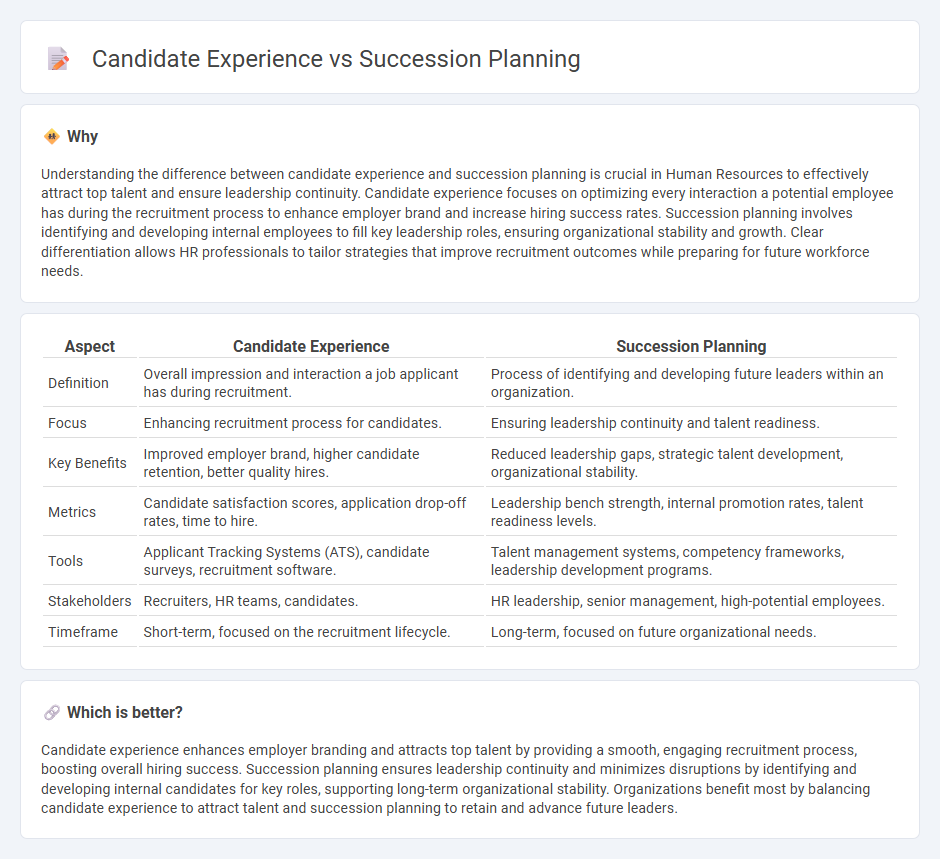
Candidate experience focuses on optimizing the recruitment journey to attract and retain top talent, ensuring clear communication, timely feedback, and a positive employer brand throughout the hiring process. Succession planning strategically identifies and develops internal employees to fill key leadership roles, maintaining organizational stability and long-term growth. Explore in-depth strategies to enhance your HR framework by balancing candidate experience with effective succession planning.
Why it is important
Understanding the difference between candidate experience and succession planning is crucial in Human Resources to effectively attract top talent and ensure leadership continuity. Candidate experience focuses on optimizing every interaction a potential employee has during the recruitment process to enhance employer brand and increase hiring success rates. Succession planning involves identifying and developing internal employees to fill key leadership roles, ensuring organizational stability and growth. Clear differentiation allows HR professionals to tailor strategies that improve recruitment outcomes while preparing for future workforce needs.
Comparison Table
| Aspect | Candidate Experience | Succession Planning |
|---|---|---|
| Definition | Overall impression and interaction a job applicant has during recruitment. | Process of identifying and developing future leaders within an organization. |
| Focus | Enhancing recruitment process for candidates. | Ensuring leadership continuity and talent readiness. |
| Key Benefits | Improved employer brand, higher candidate retention, better quality hires. | Reduced leadership gaps, strategic talent development, organizational stability. |
| Metrics | Candidate satisfaction scores, application drop-off rates, time to hire. | Leadership bench strength, internal promotion rates, talent readiness levels. |
| Tools | Applicant Tracking Systems (ATS), candidate surveys, recruitment software. | Talent management systems, competency frameworks, leadership development programs. |
| Stakeholders | Recruiters, HR teams, candidates. | HR leadership, senior management, high-potential employees. |
| Timeframe | Short-term, focused on the recruitment lifecycle. | Long-term, focused on future organizational needs. |
Which is better?
Candidate experience enhances employer branding and attracts top talent by providing a smooth, engaging recruitment process, boosting overall hiring success. Succession planning ensures leadership continuity and minimizes disruptions by identifying and developing internal candidates for key roles, supporting long-term organizational stability. Organizations benefit most by balancing candidate experience to attract talent and succession planning to retain and advance future leaders.
Connection
Candidate experience directly influences succession planning by shaping the talent pipeline quality and engagement levels within human resources. Positive candidate experiences increase the likelihood of retaining high-potential employees who are critical to effective succession strategies. Well-crafted succession planning relies on insights derived from recruitment processes, ensuring future leadership roles are filled with skilled, motivated individuals sourced through optimized candidate journeys.
Key Terms
Succession Planning:
Succession planning ensures business continuity by identifying and developing internal talent for future leadership roles, enhancing organizational stability and reducing recruitment costs. Strategic succession pipelines improve employee retention by providing clear career progression and skill development opportunities, aligning workforce capabilities with long-term company goals. Discover how effective succession planning drives sustainable growth and leadership readiness in your organization.
Talent Pipeline
Succession planning strategically identifies and develops internal talent to ensure a robust talent pipeline aligned with organizational goals, reducing recruitment costs and minimizing leadership gaps. Candidate experience influences employer branding and talent attraction, enhancing engagement and retention throughout the recruitment process. Explore how integrating succession planning with candidate experience optimizes talent pipeline strength and long-term workforce success.
Leadership Development
Succession planning ensures seamless leadership transitions by identifying and preparing high-potential candidates within the organization, enhancing long-term business stability and growth. Candidate experience during leadership development programs impacts employee engagement and retention, influencing the organization's ability to cultivate effective future leaders. Explore effective strategies to balance succession planning with a positive candidate experience for optimal leadership development outcomes.
Source and External Links
Succession Planning: All You Need To Know [2025 Edition] - Succession planning is the structured process of identifying and developing key talent to ensure business continuity by preparing internal candidates for critical leadership and specialized roles.
Succession Planning: 7-Step Guide & Template - It is a proactive strategy to identify employees who can fill vital roles, develop their skills, and create a talent pipeline to maintain organizational stability during transitions.
Succession planning - This process involves identifying potential leaders, defining the skills needed for key positions, and preparing internal candidates to step into those roles, ensuring smooth leadership transitions across organizations.
 dowidth.com
dowidth.com